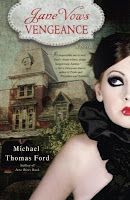
by Craig Thompson, 671 pages
Habibi recounts the story of Dodola and Zam, two souls lost to a world of poverty, slavery, and violence. They meet by chance as children and become one another's sole support, only to be parted first emotionally by the simple fact of growing up and then physically by fate. Will they see one another again? If so, in what roles? And is there any future for them that doesn't involve further suffering?
I enjoyed this visually appealing, ambitious graphic novel, but with a good many reservations.
Things I liked include the focus on the power of words and the role of written language as symbolism, art, and talisman, as well as simple communication. I also enjoyed the religious history lessons as the characters consider the differences and commonalities of the Qur'an and the Torah and try to find comfort there in the face of hardship. And then there is the arresting, detailed, often lovely artwork. Clearly, Thompson researched the heck out of his subject before setting pen to paper. Most importantly, I cared about the characters and fretted over their misfortunes and fragile happiness.
Things with which I was less enamored include the focus on sex; its role in / hold on the mind, body, and spirit; and the denial of self and the disconnect that result from trauma and abuse. This would not be a complaint, actually, were it not for the inequality in the author-artist's portrayals of men and women. In the artwork, the female body gets much more (and much more detailed) exposure than the male. Even though a major male antagonist often runs around naked, his modesty is protected by strategically placed plants and other obstructions, while the women are all laid bare on the page, including in lyrical, detailed diagrams of their reproductive organs, pregnancy, and childbirth. Even Zam's occasional nakedness is hidden except for when he's an innocent child. This apparent idealization and objectification of women makes the narrative appear to have a one-sided perspective, despite the story being told from both viewpoints and despite both lead individuals experiencing sexual trauma--but again, it's unequal, as Dodola's is forced on her whereas Zam's is self-imposed. While both are clearly victims, Dodola is acted upon while Zam acts, and this is the case for a good deal of the story. Similarly, the book's women are physically beautiful, while the men are comic, ugly, ordinary, fat, and monstrous. Despite the prominent role of a harem in the story, women are far less developed or individualized. Other than religious references, the only woman besides Dodola with any depth (or a name?!) is Nadidah, and she abruptly disappears following a tragic event. But the males are distinct from one another and more spotlighted as individuals, however unpleasant most of them may be. Is this a product of the patriarchal society depicted, of Dodola's physical and emotional isolation, or does the author really not realize how unbalanced his perspective is? Considering I had similar issues with his earlier work
Blankets, I worry it's the latter (although at the time I read it I just attributed it to his main character's adolescent obsessions). As a female reader, this pervasive inequality made me uncomfortable and undermined my trust in the legitimacy of the author's voice and vision.
Another concern is the depiction of race. Dark-skinned characters, including Zam as he gets older, look exceptionally cartoony, bordering on caricature. And some of the Arab males are similarly exaggerated stereotypes, with the large-lipped, rotund, hairy, wife-murdering sultan and a sunglasses-sporting, Gaddafi-esque rapist among them. I found this aspect of the art distracting and even offensive.
Lastly, there are the issues of time. The story's chronology initially confuses the reader, as the narrative jumps back and forth to different stages in Dodola and Zam's lives and it takes a bit for the reader to get used to the visual cues that indicate the changes. There is also the inconclusively communicated time period in which the story is meant to be set. It feels like a century or two or more in the past until the reader is presented with a modern cityscape complete with skyscrapers and motorized vehicles about four-fifths of the way through the book. The jarring effect of this revelation pulls the reader right out of the story as she tries to reinterpret everything she's read up until then in an entirely different context.
So. Despite my criticisms, I did actually enjoy the book. But my complaints are many and sincere and I don't know that I could recommend it to someone without a fair warning. It'd be interesting to see how a male reader addresses these issues. He'd probably see things I didn't, too, so it certainly offers good fodder for discussion.
 473 pages
473 pages










































